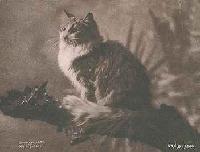 |
| postcard by Bullard |
|
Inbreeding: The mating between animals that are more closely related than the average relationship in the breed. In common usage, inbreeding refers to matings between close relatives, such as father to daughter, brother to sister, and half-brother to half sister. Planned breeding programs often use this strategy of breeding to concentrate desired genes in the breeding stock, and fix a "type", or "look". It is a process that exposes both the good and bad qualities in the stock. If the strain does carry a mutant, recessive gene (harmful or beneficial), it is more likely to become apparent sooner with inbreeding. The school of thought is that, although this might result in a high rate of defective kittens in the short term, the negative trait's exposure (and elimination from the program) in the long term is in the best interests of the breed.
Line-breeding: In common usage, matings when there are common ancestors within the first 4 or 5 generations, generally matings less close than inbreedings.
Inbreeding Depression: Loss of vigor due to the homozygosity of an increasing number of genes. The inter-breeding of related cats, generation after generation, increases the probability that the offspring inherits identical genes, over and over again. This may result in an individual with a smaller variety of different genes in it's makeup. This in turn leads to the immune system becoming less effective. Cats can only produce antibodies with the genes they have, the smaller the number of different genes, the smaller the number of different antibodies produced. The ability of an animal to generate antibodies is drastically reduced if it loses its genetic diversity, in other words, comes from a small gene pool. There may be greater proneness to illness, with longer recovery times. Kittens may be smaller, lethargic, with poor growth, or stillborn. Reproductive performance may be compromised.
Outcross: Mating cats of different bloodlines. Close inbreeding for three or four generations usually leads to fixing of type, after which further improvement becomes more difficult. At this point the vitality of the strain may begin to suffer. There could be increased reproductive problems or a weakened immune system. Many breeders find it wise to bring in new blood. This produces an "outcross litter" and the resulting kittens may show an improvement in health and vigor from the time they are born.
Foundation Cat: A foundation cat is one whose parents, as far as we know, have contributed to the gene pool only through that particular cat. For example, Bridget, parents, unknown x unknown, is a foundation cat. Her parents may have contributed other cats to the gene pool, but are assumed not to have, if there no evidence to the contrary. A "foundation cat" by this definition has a relatively unique combination of genes to offer, relative to other cats of the breed. The foundation cats referred to on this site are those which established the Maine Coon breed before the stud books were closed, as opposed to "new foundation" cats, which are introduced into an already established gene pool. Bringing in new foundation blood is a lengthy and difficult process involving several generations and registries.
Gene: Segment of the DNA, generally a region that codes for a single protein. Genes are carried on chromosomes. Cats normally have 19 pairs of chromosomes.
Locus: A site on a chromosome. Every gene belongs to a locus, but several genes can belong to the same locus.
Allele: A variant of a gene (a particular sequence). If two alleles within a diploid individual are identical by descent (that is, both alleles are direct descendants of a single allele in an ancestor), such alleles are called autozygous. If the alleles are not identical by descent (as far as is known), they are called allozygous.
Genotype: The alleles carried by an individual at a gene. The genetic makeup of the cat.
Phenotype: The outward appearance of the cat, what the cat looks like.
Haploid: Individuals that carry one copy of each gene.
Diploid: Individuals that carry two copies of each gene.
Homozygote: Individual that carries two identical alleles.
Heterozygote: Individual that carries two different alleles.
Homozygous: The two genes in a pair are the same, for example two recessives or two dominants.
Heterozygous: The two genes in a pair are different. For example, one mackerel tabby gene (dominant) and one classic tabby gene (recessive). The individual will display the characteristics of the dominant gene, but can pass on the characteristics of the recessive gene to offspring.
Population: An interbreeding group of organisms; demes - partially isolated subdivisions.
Gene Pool: The collection of alleles available among reproductive members of a population.
The inbreeding coefficient measures the probability that two alleles are identical by descent (autozygous). It is a measure of the proportion of genes that are homozygous because of the relationship between the parents. In other words, it is the percentage of probability that a particular gene is homozygous due to the relationship between the parents. So 100 % would mean that the cat is homozygous in every gene. That is, for every gene the cat inherited from the mother, an identical gene was also inherited from the father. This occurs when the father and the mother are closely related. An inbreeding coefficient of 0 % would mean that no gene is homozygous because of any relationship between the parents. (However, genes can be homozygous by coincidence). If the inbreeding coefficient is 0 %, it means that the parents of the cat are not related.
Some examples:
When a cat is mated with a sister/brother: 25 %
When a cat is mated with a parent: 25 %
When a cat is mated with a half sister/half brother: 12.5 %
When a cat is mated with a grandparent: 12.5 %
When a cat is mated with a cousin: 6.25 %
|